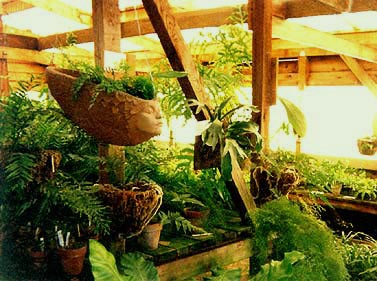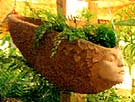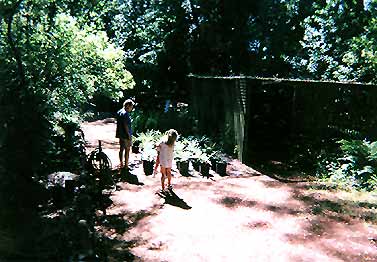
Yerba Buena Nursery
California Native Plants, Ferns, Garden Shop, Tea Terrace
About Yerba Buena Nursery

Yerba Buena Nursery is California's oldest nursery specializing in Native Plants and Ferns. This retail nursery was established in 1960 by the late Gerda Isenberg, a pioneer in the movement to recognize the landscape value of Native Plants. On her family's 3000 acre cattle ranch, Gerda fashioned a nursery dedicated to the propagation of these special plants, many of which are now rare, endangered or extinct in the wild.
The plants are grown and displayed in a series of charming lathe houses, greenhouses and wide open spaces surrounded by Redwood trees, creeks, a historic barn and farmhouse, dating to 1905. Located in the coastal hills above Woodside, over 600 species of plants are grown here from seeds, cuttings and divisions. These plants represent all regions of California from the beaches to the Sierras.
| This is an informational page about yerba buena. It is not their official website. Please visit www.yerbabuenanursery.com for more information. |
Guests are welcome to contemplate their visit over a cup of tea in our Tea Terrace which offers catered High Tea mid-week by reservation, or a casual beverage and pastry on the weekends during normal business hours. A Garden Shop offers books, seeds and charming collectible items appropriate to this country setting.
Yerba Buena's owner, Kathy Crane and fine staff of nursery professionals are happy to help with appropriate plant selection on an individualized basis. For hours of operation please visit their website www.yerbabuenanursery.com or call (650) 851-1668.
![]()
Why Grow Natives?
 There
are any number of reasons to grow native plants. They are a diverse and beautiful
group of plants. They do well in our climate, after all this is where they evolved.
And perhaps most importantly, they lend a sense of place, a connection to the
landscape that we all inhabit.
There
are any number of reasons to grow native plants. They are a diverse and beautiful
group of plants. They do well in our climate, after all this is where they evolved.
And perhaps most importantly, they lend a sense of place, a connection to the
landscape that we all inhabit.
California is blessed with incredible diversity in its plant life. This diversity is due, in part, to its size and range of habitats, from the rain forests of the north, to the deserts of the south. It encompasses the vast prairies of the Central Valley as well as the incredible heights of the Sierras.
Each of these areas has its own unique group of plants, many of which are well suited for the garden. These plants have evolved to fill every niche in the state, and many are accustomed to the long, hot summers and cool, wet winters of our Bay Area. They have displayed their resiliency through both our recent drought and freeze.
A native garden provides a place not only for plants, but for the vast array of animal life, insects, birds and butterflies that depend on these plants for survival. They in turn bring life, interest and beauty to the garden. Growing native plants encourages us to take a closer look at where we live. A garden of plants from your area is a reminder of what it is you love about California each time you step out your door; the riot of color in the spring; the smell of chaparral in the summer sun; the falling leaves of autumn; and the cool delicious rains of winter that start it all over again.
What Happened To California?
When Europeans first came to California they thought they had found Paradise. The vegetation was so lush and splendid that both horse and man had trouble wading through it. In diaries and letters home they mentioned again and again the impression that the entire territory was like a park-endless vistas of bunch grass, wild flowers and enormous, stately trees. Vast herds of elk and antelope surged through, grazing lightly and moving on. The coast ranges and the Great Valley contained almost no scrub underbrush or cover as we know it today.
The catastrophic transformation of California's ecology was caused by many factors- overgrazing, the introduction of annual grasses, erosion, herbicides/pesticides/fertilizer, irrigation, mass killing off of indigenous fauna, monoculture, logging, road building, residential development, the "control" of fire and natural drainage. But of all these, overgrazing holds the greatest responsibility.
The California Spanish used cattle hides and tallow for money. In any given year in the late 1700's and early 1800's as many as 100,000 hides passed out through each port. For every hide shipped, many stayed on to graze as reproductive stock, too young, too hard to round up. (The Spanish didn't build fences.) It is no exaggeration to say that millions of cattle- and sheep-ate the heart of California's native ecology almost to the point of disappearance in a few generations, just a geological instant.
The entire process can be illustrated in a microcosm by the story of the bunch grasses. California's native grasses, which covered thousands of square miles, virtually all the entire coastal ranges and Great Valley, were perennial. They had deep roots and stayed green for much of the year (many all year) and served admirably to prevent erosion. Many types lived, it has recently been learned, as long as 200 years. With that kind of longevity they didn't have to have much reproductive power.
The bunch grass growth pattern has interesting character. Each plant (some species as small as 9" across, others as broad as 6' or more) prefers space between itself and its neighbors, so what you see is a cluster of distinct individuals in a large company of associates. When the blades relax in the summer each one looks from a distance like a small wave on a summer pond, with the upright panicles (seed stem and head) swaying or drooping (depending on its form) in the wind.
But this give-me-some-space distinctiveness was both the bunchgrass's blessing and its downfall. Before the European intrusion, the spaces between individual plants were filled with wild flowers and bulbs which grew, bloomed and fell dormant on their own schedules, creating an ever-changing oriental carpet of extraordinary beauty. Then came the cattle and sheep.
The domestics had grazing habits different from the native grazers, which clipped the top and moved on. Domestics-especially sheep, but also cattle-tend to eat grass down to the ground, even wrenching it up from its roots. The perennial grasses were much more nutritious and tasty, too, than the rye and oats the ranchers imported. So the cattle and sheep killed one long-lived, not-very-fertile plant after another, by the millions...And left behind in their excretions the seeds of their annual competitors, which found fertile ground in those very spaces in between.
An annual grass, by definition, has to work fast. It must sprout, bloom, set seed and die all within a few months. It doesn't have much in the way of roots, because it gets its water from from precipitation and whatever is readily available near the surface. It has no power to keep the topsoil on the hillside. But it sure knows how to reproduce.
You can see the difference yourself between the way an annual and a perennial go about the business of living when you plant their flower seeds in flats at the same time. Some annual flowers will even be blooming before your perennial seedlings are ready to be transplanted out. So the annual grasses, and the weeds that accompanied them from the Old World found a reluctantly generous hospitality in the New. We see the result.
Today the ecological consciousness of Californians is germinating, taking root, and in some people and places, beginning to bloom. An expanding awareness of the value of native plants is just one manifestation. Each native plant patch in the garden of each aware person is a blossom in the cracks of ignorance and indifference. If Californians up to now have neither known any better nor cared, the planet has finally forced our hands. We don't have the water, the time or the money to continue the horticultural pretense that we live in northern Europe. What a wonder.

Exotic ferns for sale at Yerba Buena
We woke up before it was too late, before the plants that have always lived here, and could put their beauty and adaptive capacity at our disposal, had vanished. We are embarked upon a great adventure, just beginning to learn how to live with the natives. Like the bunch-grasses, we each want a little space around us so as to leave room for the flowers. And like the bunch grasses, when we grow together we are each a small wave on a spreading pond.
Vist Yerba Buena's Official Website
Reprinted from Growing Native Newsletter , PO Box 489, Berkeley, CA 94701 Copyright 1990 by Louise Lacey. Permission to reprint granted so long as this page is reproduced in its entirety.